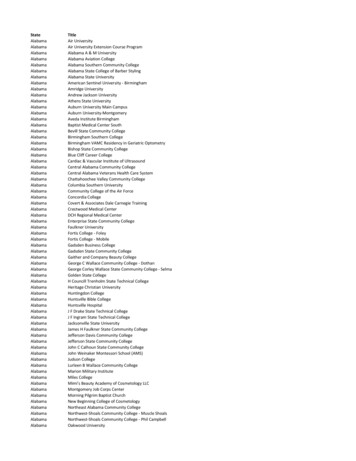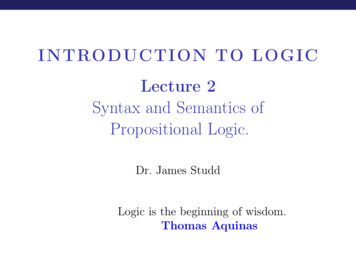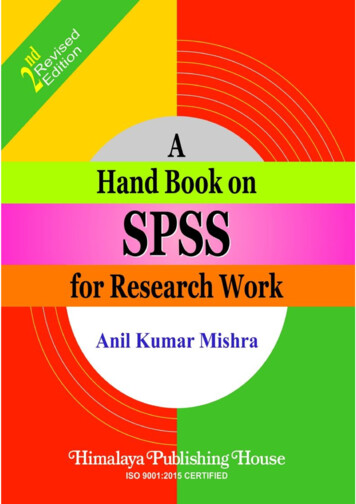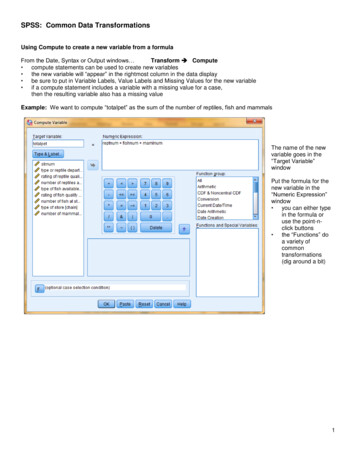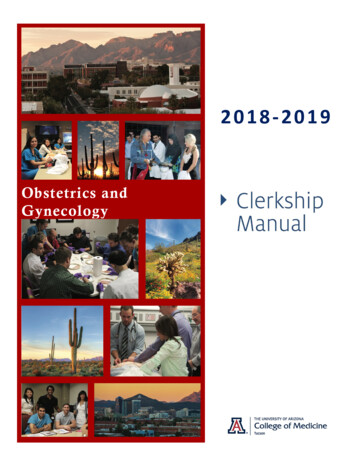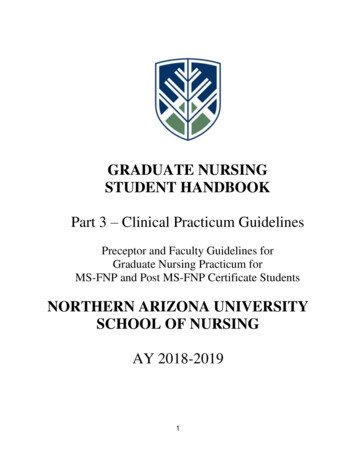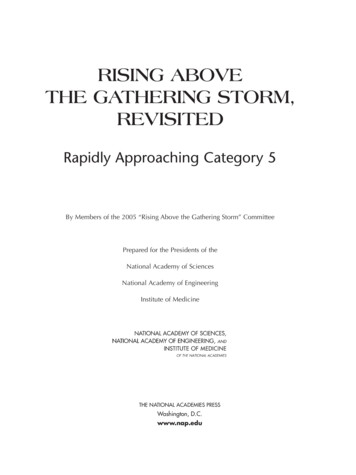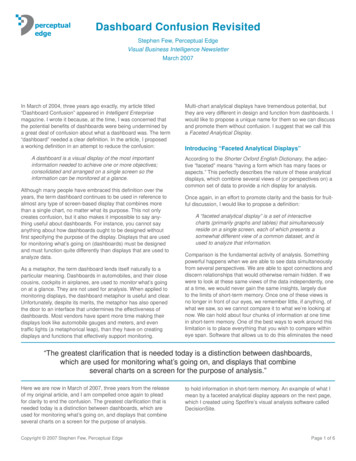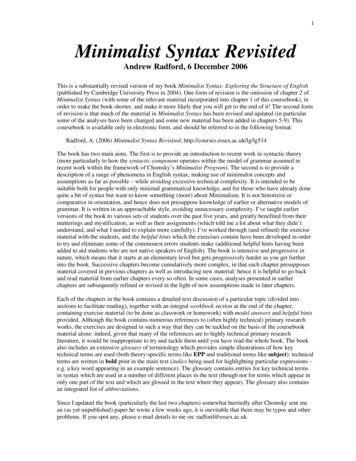
Transcription
1Minimalist Syntax RevisitedAndrew Radford, 6 December 2006This is a substantially revised version of my book Minimalist Syntax: Exploring the Structure of English(published by Cambridge University Press in 2004). One form of revision is the omission of chapter 2 ofMinimalist Syntax (with some of the relevant material incorporated into chapter 1 of this coursebook), inorder to make the book shorter, and make it more likely that you will get to the end of it! The second formof revision is that much of the material in Minimalist Syntax has been revised and updated (in particularsome of the analyses have been changed and some new material has been added in chapters 5-9). Thiscoursebook is available only in electronic form, and should be referred to in the following format:Radford, A. (2006) Minimalist Syntax Revisited, http://courses.essex.ac.uk/lg/lg514The book has two main aims. The first is to provide an introduction to recent work in syntactic theory(more particularly to how the syntactic component operates within the model of grammar assumed inrecent work within the framework of Chomsky’s Minimalist Program). The second is to provide adescription of a range of phenomena in English syntax, making use of minimalist concepts andassumptions as far as possible – while avoiding excessive technical complexity. It is intended to besuitable both for people with only minimal grammatical knowledge, and for those who have already donequite a bit of syntax but want to know something (more) about Minimalism. It is not historicist orcomparative in orientation, and hence does not presuppose knowledge of earlier or alternative models ofgrammar. It is written in an approachable style, avoiding unnecessary complexity. I’ve taught earlierversions of the book to various sets of students over the past five years, and greatly benefited from theirmutterings and mystification, as well as their assignments (which told me a lot about what they didn’tunderstand, and what I needed to explain more carefully). I’ve worked through (and refined) the exercisematerial with the students, and the helpful hints which the exercises contain have been developed in orderto try and eliminate some of the commonest errors students make (additional helpful hints having beenadded to aid students who are not native speakers of English). The book is intensive and progressive innature, which means that it starts at an elementary level but gets progressively harder as you get furtherinto the book. Successive chapters become cumulatively more complex, in that each chapter presupposesmaterial covered in previous chapters as well as introducing new material: hence it is helpful to go backand read material from earlier chapters every so often. In some cases, analyses presented in earlierchapters are subsequently refined or revised in the light of new assumptions made in later chapters.Each of the chapters in the book contains a detailed text discussion of a particular topic (divided intosections to facilitate reading), together with an integral workbook section at the end of the chapter,containing exercise material (to be done as classwork or homework) with model answers and helpful hintsprovided. Although the book contains numerous references to (often highly technical) primary researchworks, the exercises are designed in such a way that they can be tackled on the basis of the coursebookmaterial alone: indeed, given that many of the references are to highly technical primary researchliterature, it would be inappropriate to try and tackle them until you have read the whole book. The bookalso includes an extensive glossary of terminology which provides simple illustrations of how keytechnical terms are used (both theory-specific terms like EPP and traditional terms like subject): technicalterms are written in bold print in the main text (italics being used for highlighting particular expressions –e.g. a key word appearing in an example sentence). The glossary contains entries for key technical termsin syntax which are used in a number of different places in the text (though not for terms which appear inonly one part of the text and which are glossed in the text where they appear). The glossary also containsan integrated list of abbreviations.Since I updated the book (particularly the last two chapters) somewhat hurriedly after Chomsky sent mean (as yet unpublished) paper he wrote a few weeks ago, it is inevitable that there may be typos and otherproblems. If you spot any, please e-mail details to me on: radford@essex.ac.uk
2ContentsSectionpage1 Grammar1.1 Overview . 51.2 Traditional Grammar: Categories and Functions . 51.3 Universal Grammar 111.4 The Language Faculty 131.5 Principles of Universal Grammar . 161.6 Parameters . 171.7 Parameter-setting . 201.8 Summary 23Workbook section 242 Structure2.1 Overview 292.2 Phrases 292.3 Clauses 322.4 Specifiers 352.5 Intermediate and maximal projections 382.6 Testing structure 412.7 Syntactic relations . 442.8 Bare Phrase Structure .472.9 Summary . . 49Workbook section . 503 Null constituents3.1 Overview 593.2 Null subjects . 593.3 Null auxiliaries 623.4 Null T in auxiliariless finite clauses 653.5 Null T in bare infinitive clauses 693.6 Null C in finite clauses 703.7 Null C in non-finite clauses 733.8 Defective clauses 753.9 Case properties of subjects 773.10 Null determiners and quantifiers. 813.11 Summary 84Workbook section 85
34 Head Movement4.1 Overview 904.2 T-to-C movement 904.3 Movement as copying and deletion 924.4 V-to-T movement 954.5 Head Movement . 984.6 Auxiliary raising . . 1014.7 Another look at negation 1034.8 Do-support . 1064.9 Head movement in nominals . 1094.10 Summary . 111Workbook section .1125 Wh-movement5.1 Overview 1165.2 Wh-questions 1165.3 Wh-movement as copying and deletion . 1185.4 Driving wh-movement and auxiliary inversion 1225.5 Pied-piping . . 1255.6 Long-distance wh-movement . 1315.7 Multiple wh-questions . 1355.8 Wh-subject questions . 1385.9 Exclamative and relative clauses . 1415.10 Summary . 149Workbook section 1506 A-movement6.1 Overview .1546.2 Subjects in Belfast English .1546.3 Idioms . .1566.4 Argument structure and theta-roles .1576.5 Unaccusative predicates .1616.6 Passive predicates 1656.7 Long-distance passivisation 1686.8 Raising .1716.9 Comparing raising and control predicates .1726.10 Summary 176Workbook section .177
47 Agreement, Case and Movement7.1 Overview .1817.2 Agreement 1817.3 Feature valuation .1837.4 Uninterpretable features and feature deletion .1847.5 Expletive it subjects 1877.6 Expletive there subjects .1907.7 Agreement and A-movement .1957.8 EPP and agreement in control infinitives. 1967.9 EPP and person agreement in defective clauses. 1987.10 Defective clauses with expletive subjects .2017.11 Summary. 204Workbook section 2068 Split Projections8.18.28.38.48.5Overview Split CP: Force, Topic and Focus projections Split CP: Finiteness projection .Split TP: Aspect projection Split TP: Mood projection. . . 2092092142172198.6 Split VP: Ergative structures . . 2218.7 Split VP: Other transitive structures . 2258.8 Split VP: Exceptional Case Marking and Object Control. 2298.9 Split VP: Intransitive clauses . 2318.10 Summary . . 237Workbook section 2389 Phases9.1 Overview 2429.2 Phases 2429.3 Intransitive and defective clauses . . 2459.4 Phases and A-bar movement . . 2489.5 A-bar movement in transitive clauses . . . 2519.6 Uninterpretable features and feature inheritance .2559.7 Independent probes . . 2589.8 Subject questions . . 2649.9 More on subextraction . . . . 2679.10 Summary 269Workbook section 271Glossary .276References .309
51.Grammar1.1 OverviewIn broad terms, this book is concerned with aspects of grammar. Grammar is traditionallysubdivided into two different but inter-related areas of study – morphology and syntax. Morphology isthe study of how words are formed out of smaller units (called morphemes), and so addresses questionssuch as ‘What are the component morphemes of a word like antidisestablishmentarianism, and what is thenature of the morphological operations by which they are combined together to form the overall word?’Syntax is the study of the way in which phrases and sentences are structured out of words, and soaddresses questions like ‘What is the structure of a sentence like What’s the president doing? and what isthe nature of the grammatical operations by which its component words are combined together to form theoverall sentence structure?’ In this chapter, we begin (in §1.2) by taking a brief look at the approach to thestudy of syntax taken in traditional grammar: this also provides an opportunity to introduce some usefulgrammatical terminology. In the remainder of the chapter, we look at the approach to syntax adoptedwithin the theory of Universal Grammar developed by Chomsky.1.2 Traditional Grammar: Categories and FunctionsWithin traditional grammar, the syntax of a language is described in terms of a taxonomy (i.e.classificatory list) of the range of different types of syntactic structures found in the language. The centralassumption underpinning syntactic analysis in traditional grammar is that phrases and sentences are builtup of a series of constituents (i.e. syntactic units), each of which belongs to a specific grammaticalcategory and serves a specific grammatical function. Given this assumption, the task of the linguist inanalysing the syntactic structure of any given type of sentence is to identify each of the constituents in thesentence, and (for each constituent) to say what category it belongs to and what function it serves. Forexample, in relation to the syntax of a simple sentence like:(1)Students protestedit would traditionally be said that the sentence consists of two constituents (the word students and theword protested), that each of these constituents belongs to a specific grammatical category (students beinga plural noun and protested a past tense verb) and that each serves a specific grammatical function(students being the subject of the sentence, and protested being its predicate). The overall sentenceStudents protested has the categorial status of a clause which is finite in nature (by virtue of denoting anevent taking place at a specific time), and has the semantic function of expressing a proposition which isdeclarative in force (in that it is used to make a statement rather than e.g. ask a question). Accordingly, atraditional grammar of English would tell us that the simplest type of finite declarative clause found inEnglish is a sentence like (1) in which a nominal subject is followed by a verbal predicate. Let’s brieflylook at some of the terminology used here.In traditional grammar, words are assigned to grammatical categories (called parts of speech) on thebasis of their semantic properties (i.e. meaning), morphological properties (i.e. the range of differentforms they have), and syntactic properties (i.e. word-order properties relating to the positions they canoccupy within sentences): a set of words which belong to the same category thus have a number ofsemantic, morphological and syntactic properties in common. There are traditionally said to be twodifferent types of word, namely content words/contentives ( words which substantive lexical content)on the one hand and function words/functors ( words which essentially serve to mark grammaticalproperties) on the other. The differences between the two can be illustrated by comparing a contentive likecar with a functor like the pronoun they. A noun like car has substantive lexical content in that it denotesan object which typically has four wheels and an engine, and it would be easy enough to draw a picture ofa typical car; by contrast, a pronoun such as they has no descriptive content (e.g. you can’t draw a pictureof they), but rather is a functor which simply marks grammatical (more specifically, person, number andcase) properties in that it is a third person plural nominative pronoun. Because they have lexical semantic
6content, content words often (though not always) have antonyms (i.e. ‘opposites’) – e.g. the adjective tallhas the antonym short, the verb increase has the antonym decrease, and the preposition inside has theantonym outside: by contrast, a typical function word like e.g. the pronoun me has no obvious antonym.Corresponding to these two different types of (content and function) word are two different kinds ofgrammatical category – namely lexical/substantive categories ( categories whose members are contentwords) on the one hand, and functional categories ( categories whose members are function words) onthe other.Let’s begin by looking at the main lexical/substantive categories found in English – namely, noun,verb, adjective, adverb and preposition (conventionally abbreviated to N, V, A, ADV and P in order tosave space). Nouns ( N) are traditionally said to have the semantic property that they denote entities: so,bottle is a noun (since it denotes a type of object used to contain liquids), water is a noun (since it denotesa type of liquid), and John is a noun (since it denotes a specific person). There are a number of distinctsubtypes of noun: for example a noun like chair is a count noun in that it can be counted (cf. one chair,two chairs ), whereas a noun like furniture is a mass noun in that it denotes an uncountable mass (hencethe ungrammaticality of *one furniture, *two furnitures – a prefixed star being used to indicate that anexpression is ungrammatical). Likewise, a distinction is traditionally drawn between a common noun likeboy (which can be modified by a determiner like the – as in The boy is lying) and a proper noun likeAndrew (which cannot be used in the same way, as we see from the ungrammaticality of *The Andrew islying). Count nouns generally have the morphological property that they have two different forms: asingular form (like horse in one horse) used to denote a single entity, and a plural form (like horses intwo horses) used to denote two or more entities. Common nouns have the syntactic property that only (anappropriate kind of) noun can be used to end a four-word sentence such as They have no. In place of thedots here we could insert a singular count noun like car, or a plural count noun like friends, or a massnoun like money, but not other types of word (e.g. not see, or slowly, or up, since these are not nouns).A second lexical/substantive category is that of verb ( V). These are traditionally said to have thesemantic property that they denote actions or events: so, eat, sing, pull, and resign are all (action-denoting)verbs. From a syntactic point of view, verbs have the property that only an appropriate kind of verb (in itsuninflected form) can be used to complete a three-word sentence such as They/It can. So, words like stay,leave, hide, die, starve and cry are all verbs and hence can be used in place of the dots here (but words likeapple, under, pink, and if aren’t). From a morphological point of view, regular verbs like cry in Englishhave the property that they have four distinct forms: e.g. alongside the bare (i.e. uninflected) form cry wefind the present tense form cries, the past tense/perfect participle/passive participle form cried and theprogressive participle form crying. (See the glossary of terminology at the end of this book if you are notfamiliar with these terms.)A third lexical/substantive category is that of adjective ( A). These are traditionally said to have thesemantic property of denoting states or attributes (cf. ill, happy, tired, conscientious, red, cruel, old etc.).They have the syntactic property that they can occur after be to complete a four-word sentence like Theymay be (as with They may be tired/ill/happy etc.), and the further syntactic property that (if they denotea gradable property which can exist in varying degrees), they can be modified by a degree word likevery/rather/somewhat (cf. She is very happy). Many (but not all) adjectives have the morphologicalproperty that they have comparative forms ending in -er and superlative forms ending in -est (cf.big/bigger/biggest).A fourth lexical/substantive category is that of adverb ( ADV). These often have the semanticproperty that they denote the manner in which an action is performed (as with well in She sings well).Regular adverbs have the morphological property that they are formed from adjectives by the addition ofthe suffix -ly (so that corresponding to the adjective sad we have the adverb sadly). A syntactic property ofadverbs is that an adverb (like e.g. badly) is the only kind of word which could be used to end a two-wordsentence like She behaved ---, a three-word sentences like He treats her ---, or a four-word sentence likeHe worded the statement ---.The fifth and final lexical/substantive category found in English is that of preposition ( P). Many ofthese have the semantic property of marking location (cf. in/on/off/inside/outside/under/above/below).They have the syntactic property that a preposition (with the appropriate kind of meaning) can be modifiedby right in the sense of ‘completely’, or by straight in the sense of ‘directly’ (as with the preposition downin He fell right down the stairs and the preposition to in He went straight to bed). Prepositions have the
7morphological property that they are invariable/uninflected forms (e.g. the preposition off has no pasttense form *offed, no superlative form *offest, and so on).In addition to the five lexical/substantive categories identified above, English also has a number offunctional categories. One such functional category is that of determiner ( D) – a category whosemembers are traditionally said to include the definite article the and the demonstrative determinersthis/that/these/those. They are called determiners because they have the semantic property that theydetermine specific semantic properties of the noun expression that they introduce, marking it as a definitereferring expression: for example, an expression like the car in a sentence such as Shall we take the car? isa definite referring expression in the sense that it refers to a definite (specific) car which is assumed to befamiliar to the hearer/addressee. (On the nature of determiners, see Spinillo 2004.) A related class ofwords are those which belong to the functional category quantifier ( Q), denoting expresions of quantity(e.g. some/all/no/any/each/every/most/much/many).A further type of functional category found in English is that of pronoun ( PRN). Pronouns are itemswhich are said to ‘stand in place of’ (the meaning of the prefix pro-) or ‘refer back to’ noun expressions.However, there are reasons to think that there are a number of different types of pronoun found in Englishand other languages (See Déchaine and Wiltschko 2002). For example, in sentences such as John has ared car and Jim has a blue one, the word one is traditionally said to be a pronoun because it has no lexicalsemantic content of its own, but rather takes its content from its antecedent (i.e. one refers back to thenoun car and so one is interpreted as having the same meaning as car). However, from a morphologicalperspective, the pronoun one behaves like a regular count noun in that it has a plural form ending in -s (asin I’ll take the green apples if you haven’t got any red ones). So, more accurately, we could say that one isan N-pronoun (or pronominal noun). By contrast, in a sentence like Many miners were rescued, but somedied, the word some seems to function as a Q-pronoun (i.e. a pronominal quantifier). And in a sentencelike These apples are ripe, but those aren’t, the word those seems to be a D-pronoun (i.e. a pronominaldeterminer). Indeed, some linguists have argued that so-called personal pronouns like I/me/we/us/you/he/him/she/her/it/they/them are also D-pronouns: the rationale for this is that some such pronouns can beused as determiners which modify a following noun (as in We republicans don’t trust you democrats,where we could be argued to be a determiner modifying the noun republicans, and you could be seen as adeterminer modifying the noun democrats). While, as noted here, pronouns can be argued to belong to anumber of distinct types of category, in order to simplify discussion I shall simply refer to them asbelonging to the category PRN throughout this book.Another type of functional category found in English is that of auxiliary. They have the semanticproperty of marking grammatical properties such as tense, aspect, voice, or mood (See the Glossary ofterminology at the end of the book if you are not sure what these terms mean). Auxiliaries have thesyntactic property that (unlike lexical/main verbs) they can be inverted with their subject in questions (sothat corresponding to a statement like It is raining we have the question Is it raining, where the auxiliary ishas moved in front of the subject it). The items italicised in (2) below (in the use illustrated there) aretraditionally categorised as auxiliaries taking a [bracketed] complement containing a bold-printed verb:(2)(a)(c)(e)(g)He has/had [gone]They are/were [taken away for questioning]You can/could [help us]He will/would [get upset](b)(d)(f)(h)She is/was [staying at home]He really does/did [say a lot]They may/might [come back]I shall/should [return]In the uses illustrated here, have/be in (2a/b) are (perfect/progressive) aspect auxiliaries, be in (2c) is a(passive) voice auxiliary, do in (2d) an expletive or dummy auxiliary (i.e. one with no intrinsic lexicalsemantic content), and ught in (2e-h) modalauxiliaries. What auxiliaries in sentences like those above have in common is the fact that they inflect forpresent/past tense. Hence, in work in syntax over the past 10 years or so, they have been said to belong tothe category T ( tense-marker).An interesting word which has been argued to be related to tense-marking auxiliaries in work over thepast 30 years or so is the infinitive particle to, in sentences such as:(3)They are now expecting the president to be impeached tomorrowIn a sentence like (3), infinitival to seems to have future time-reference (in that the act of impeachmentwill take place at some time in the future), and this is why we can use the word tomorrow in the to-clause.
8In this respect, infinitival to seems to have much the same function as the auxiliary will in They are nowexpecting that the president will be impeached tomorrow. If infinitival to is indeed an infinitival tensemarker, then it belongs to the same category T as present/past tense auxiliaries such as is/was. Thedifference between auxiliaries and infinitival to is that most auxiliaries overtly inflect for present/pasttense (though this is not true of the invariable auxiliary must), whereas infinitival to is invariable in form.(For a technical discussion of tense, see Julien 2001.) We can thus say that an auxiliary like will is a finiteT constituent, whereas infinitival to is a non-finite T.The last type of functional category which we will look at is a kind of word (like each of the wordsitalicised in the examples below) which is traditionally termed a (subordinating) conjunction:(4)(a)(b)(c)I think [that you may be right]I doubt [if you can help me]I’m anxious [for you to receive the best treatment possible]Each of the bracketed clauses in (4) is a complement clause, in that it functions as the complement of theword immediately preceding it (think/doubt/anxious); for this reason, the italicised word which introduceseach clause is known in work since Bresnan (1970) as a complementiser ( C), and this is theterminology which will be adopted throughout this book. Complementisers are functors in the sense thatthey encode particular sets of grammatical properties. For example, complementisers encode(non)finiteness by virtue of the fact that they are intrinsically finite or nonfinite. More specifically, thecomplementisers that and if are inherently finite in the sense that they can only be used to introduce afinite clause (i.e. a clause containing a present or past tense auxiliary or verb, like the present-tenseauxiliaries may and can in 4a and 4b); by contrast, for is an inherently infinitival complementiser, and socan be used to introduce a clause containing infinitival to (as in 4c). Moreover, that introduces adeclarative clause (i.e. one which has the force of a statement), if introduces an interrogative clause (i.e.one which has the force of a question), and for introduces an irrealis clause (i.e. one relating to ahypothetical event which hasn’t yet taken place and may or may not take place at some stage in thefuture). Hence, we can say that is a finite declarative complementiser, if is a finite interrogativecomplementiser, and for is an infinitival irrealis complementiser.Using the set of syntactic categories outlined above, we can employ the traditional labelledbracketing technique to categorise words (i.e. assign them to grammatical categories) in a way whichdescribes how they are being used in a particular sentence such as:(5)[D The] [N president] [T is] [ADV clearly] [V feeling] [A angry] [C that] [N Congress] [T has] [V refused][T to] [V negotiate] [P with] [PRN him]The labelled bracketing in (5) tells us that the is a D/determiner, president a N/noun, is a T/present-tenseauxiliary, clearly an ADV/adverb, feeling a V/verb, angry an A/adjective, that a C/complementiser,Congress a N/noun, has a T/present-tense auxiliary, refused a V/verb, to a T/infinitival tense particle,negotiate a V/verb, with a P/preposition, and him a PRN/pronoun.The discussion of grammatical categories presented above is merely a brief sketch: for a more detaileddiscussion of the range of categories found in English see chapter 2 of my (2004) English Syntax orMinimalist Syntax books. However, it suffices to illustrate the point that when traditional grammariansanalyse the syntax of sentences, they begin by assigning each of the words in the sentence to agrammatical category which describes how it is being used in the sentence concerned. However, as notedat the beginning of this section, traditional grammarians are also concerned to describe the grammaticalfunctions which words and other expressions fulfil within the sentences containing them. We canillustrate this point in terms of the following set of sentences:(6)(a)(b)(c)(d)John smokesThe president smokesThe president of Utopia smokesThe former president of the island paradise of Utopia smokesSentence (6a) comprises the noun John which serves the function of being the subject of the sentence(and denotes the person performing the act of smoking), and the verb smokes which serves the function ofbeing the predicate of the sentence (and describes the act being performed). In (6a), the subject is the
9single noun John; but as the examples in (6b, c, d) show, the subject of a sentence can also be an(italicised) phrase like the president, or the president of Utopia or the former president of the islandparadise of Utopia.Now consider the following set of sentences:(7)(a)(b)(c)(d)John smokes cigarsJohn smokes Cuban cigarsJohn smokes Cuban cigars imported from HavanaJohn smokes a specific brand of Cuban cigars imported by a friend of his from HavanaSentence (7a) comprises the subject John, the predicate smokes and the complement (or direct object)cigars. (The complement cigars describes the entity on which the act of smoking is being performed; asthis example illustrates, subjects normally precede the verb with which they are associated in English,whereas complements typically follow the verb.) The complement in (7a) is the single noun cigars; but acomplement can also be a phrase: in (7b), the complement of smokes is the phrase Cuban cigars; in (7c)the complement is the phrase Cuban cigars imported from Havana; and in (7d) the complement is thephrase a specific brand of Cuban cigars imported by a friend of his from Havana. A verb which has anoun or pronoun expression as its direct object complement is traditionally said to be transitive.From a semantic perspective, subjects and complements share in common the fact that they generallyrepresent entities directly involved in the particular action or event described by the predicate: to use therelevant semantic terminology, we can say that subjects and complements are arguments of the predicatewith which they are associated. Predicates may have one or more arguments, as we see from sentencessuch as (8) below, where each of the bracketed nouns is a different argument of the italicised predicate:(8)(a)[Joh
literature, it would be inappropriate to try and tackle them until you have read the whole book. The book also includes an extensive glossary of terminology which provides simple illustrations of how key technical terms are used (both theory-specific terms like EPP and traditional terms like subject ): technical
